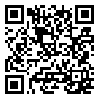Volume 61, Issue 4 (15 2003)
Tehran Univ Med J 2003, 61(4): 281-285 |
Back to browse issues page
Download citation:
BibTeX | RIS | EndNote | Medlars | ProCite | Reference Manager | RefWorks
Send citation to:



BibTeX | RIS | EndNote | Medlars | ProCite | Reference Manager | RefWorks
Send citation to:
Hasani M, Ebrahi Soltani A R. Comparison Of Inhalation Induction (Single Breath Inhalation And Tidal Volume Technique) And Intravenous Induction (Thiopental And Succinylcholine). Tehran Univ Med J 2003; 61 (4) :281-285
URL: http://tumj.tums.ac.ir/article-1-1174-en.html
URL: http://tumj.tums.ac.ir/article-1-1174-en.html
Abstract: (9068 Views)
The induction characteristic of halothane in nitrous oxide and oxygen were compared with halothane in oxygen alone and intravenous induction with thiopentum and succinylcholine.
Materials and Methods: A vital capacity technique was used for the gaseous induction groups using a mapleson F system and a 1-litre reservoir bag. four end points of anesthesia were recorded: time to cessation of hand grip, time to loss of eyelash reflex, time to jaw relaxation, and time to settled breathing after tracheal tube insertion .we also recorded sequential blood pressure and pulse rate , the incidence of adverse airway events and the acceptability of the induction technique .
Results: Induction with thiopentum and succinylcholine had a faster time to cessation of hand grip (p, 0.05) and jaw relaxation (p, 0.01). These differences disappeared with the final induction stage and halothane in nitrous oxide and oxygen had the faster time to regular settled breathing though this did not reach statistical significance. Cardiac stability was good and comparable in all groups.
Conclusion: These were few adverse airway events in any group and none caused oxygen saturation to fall below 96%. There was more excitation in the gaseous induction groups.
Materials and Methods: A vital capacity technique was used for the gaseous induction groups using a mapleson F system and a 1-litre reservoir bag. four end points of anesthesia were recorded: time to cessation of hand grip, time to loss of eyelash reflex, time to jaw relaxation, and time to settled breathing after tracheal tube insertion .we also recorded sequential blood pressure and pulse rate , the incidence of adverse airway events and the acceptability of the induction technique .
Results: Induction with thiopentum and succinylcholine had a faster time to cessation of hand grip (p, 0.05) and jaw relaxation (p, 0.01). These differences disappeared with the final induction stage and halothane in nitrous oxide and oxygen had the faster time to regular settled breathing though this did not reach statistical significance. Cardiac stability was good and comparable in all groups.
Conclusion: These were few adverse airway events in any group and none caused oxygen saturation to fall below 96%. There was more excitation in the gaseous induction groups.
| Rights and permissions | |
 |
This work is licensed under a Creative Commons Attribution-NonCommercial 4.0 International License. |





